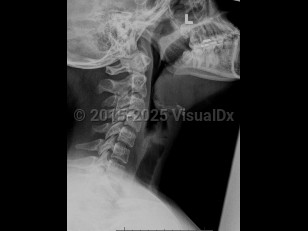Potentially life-threatening emergency
Epiglottitis
Alerts and Notices
Important News & Links
Synopsis

Epiglottitis is a potentially life-threatening inflammation of the epiglottis and supraglottic space caused by infection (eg, Haemophilus influenzae type b [Hib]) or injury (eg, foreign body, caustic substance, thermal damage). As the epiglottis swells, it can cause airway obstruction and create a medical emergency. Presenting symptoms include high fever, sore throat, difficulty swallowing, dyspnea, hoarseness, stridor, tachycardia, drooling, and hot potato voice or dysphonia.
Protection of the airway is a priority, and treatment may require placement of an artificial airway, intravenous steroids, antimicrobial therapy to control infection, and surveillance in an intensive care unit. Tracheostomy may be required in severe cases if airway management is not achievable with medical intervention or oral / nasal intubation.
The prevalence of severe epiglottitis in children has been reduced substantially in the United States and other developed countries since Hib vaccination has become a standard of care. Prior to routine immunization, the incidence of epiglottitis was approximately 5 per 100 000 children. Current estimates have the incidence at about 0.6-0.8 per 100 000 children. The incidence in adults has remained stable (0.6-1.9 per 100 000 people). Prognosis has improved, particularly when intervention is prompt, with recognition of the potentially severe airway compromise.
The leading cause of epiglottitis in children is bacterial infection. Hib remains a leading causal organism but has a markedly decreased incidence. Group A Streptococcus, Staphylococcus aureus, and H influenza types A and F, and nontypeable H influenza, in addition to viral and fungal infections, have all been associated with epiglottitis.
Since widespread immunization against Hib, the average age of epiglottitis in children has increased. Nonimmunized populations and immunocompromised individuals are at increased risk for epiglottitis.
Epiglottitis in adults is also primarily attributed to infection but from different organisms. Streptococcus pneumoniae is the leading infectious agent, with other viral, bacterial, and fungal sources described as causal agents.
In both pediatric and adult patients, trauma from burns, caustic injuries, or foreign body ingestions are potential noninfectious etiologies of epiglottitis.
Protection of the airway is a priority, and treatment may require placement of an artificial airway, intravenous steroids, antimicrobial therapy to control infection, and surveillance in an intensive care unit. Tracheostomy may be required in severe cases if airway management is not achievable with medical intervention or oral / nasal intubation.
The prevalence of severe epiglottitis in children has been reduced substantially in the United States and other developed countries since Hib vaccination has become a standard of care. Prior to routine immunization, the incidence of epiglottitis was approximately 5 per 100 000 children. Current estimates have the incidence at about 0.6-0.8 per 100 000 children. The incidence in adults has remained stable (0.6-1.9 per 100 000 people). Prognosis has improved, particularly when intervention is prompt, with recognition of the potentially severe airway compromise.
The leading cause of epiglottitis in children is bacterial infection. Hib remains a leading causal organism but has a markedly decreased incidence. Group A Streptococcus, Staphylococcus aureus, and H influenza types A and F, and nontypeable H influenza, in addition to viral and fungal infections, have all been associated with epiglottitis.
Since widespread immunization against Hib, the average age of epiglottitis in children has increased. Nonimmunized populations and immunocompromised individuals are at increased risk for epiglottitis.
Epiglottitis in adults is also primarily attributed to infection but from different organisms. Streptococcus pneumoniae is the leading infectious agent, with other viral, bacterial, and fungal sources described as causal agents.
In both pediatric and adult patients, trauma from burns, caustic injuries, or foreign body ingestions are potential noninfectious etiologies of epiglottitis.
Codes
ICD10CM:
J05.10 – Acute epiglottitis without obstruction
SNOMEDCT:
80384002 – Epiglottitis
J05.10 – Acute epiglottitis without obstruction
SNOMEDCT:
80384002 – Epiglottitis
Look For
Subscription Required
Diagnostic Pearls
Subscription Required
Differential Diagnosis & Pitfalls

To perform a comparison, select diagnoses from the classic differential
Subscription Required
Best Tests
Subscription Required
Management Pearls
Subscription Required
Therapy
Subscription Required
References
Subscription Required
Last Reviewed:02/05/2019
Last Updated:02/05/2019
Last Updated:02/05/2019
Potentially life-threatening emergency
Epiglottitis

